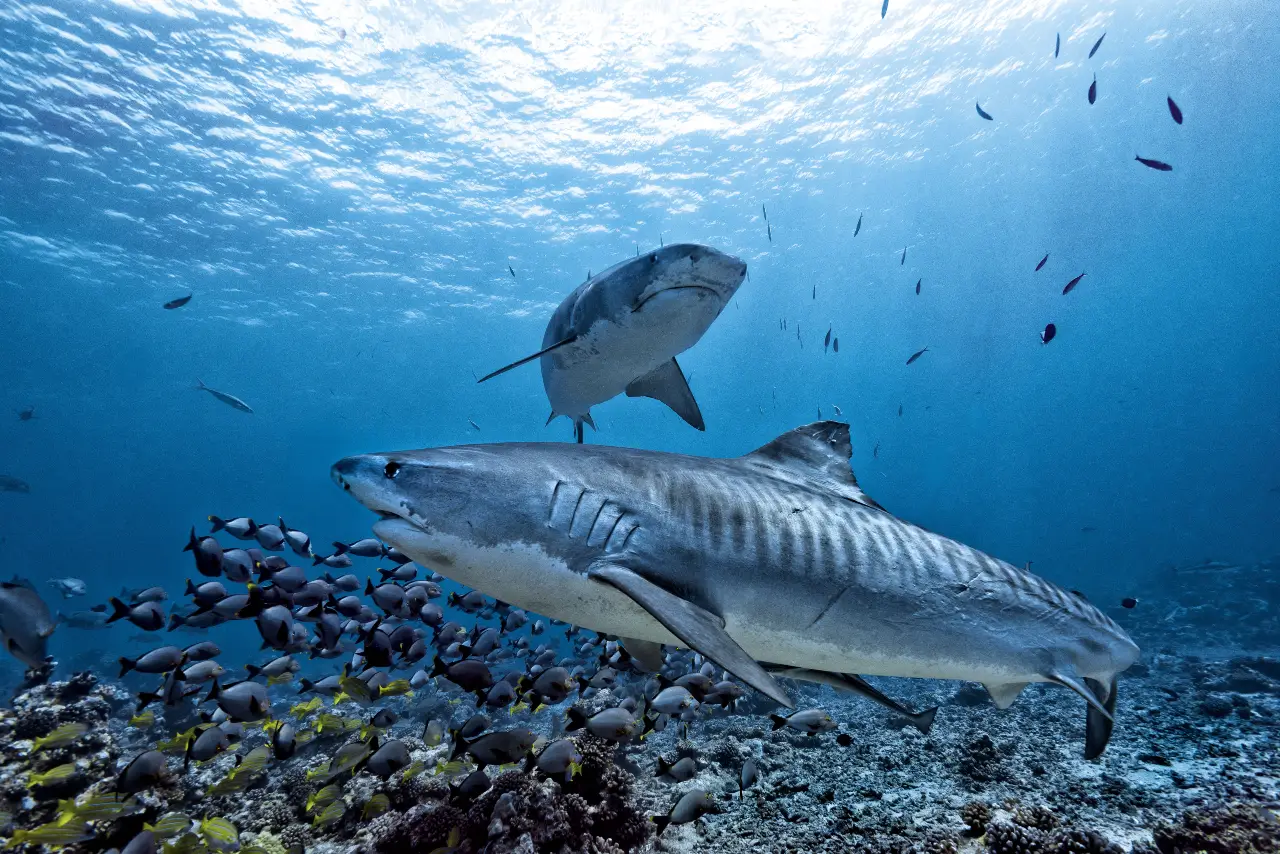Tiger Sharks in Beqa Lagoon: Nature’s Striped Predators
Diving in Fiji’s Beqa Lagoon is an adventure like no other, especially when you encounter one of the ocean’s most iconic predators—the tiger shark (Galeocerdo cuvier). Known for their distinctive stripes, formidable size, and opportunistic feeding behavior, tiger sharks are an awe-inspiring sight for shark divers. Beqa Lagoon, with its rich biodiversity and vibrant coral reefs, serves as an ideal habitat for these majestic creatures. This blog delves into the fascinating world of tiger sharks, exploring their size, habitat, behavior, and importance in the marine ecosystem.
How Big Are Tiger Sharks?
Tiger sharks are among the largest shark species in the world. Adult tiger sharks can grow between 10 to 14 feet (3 to 4.3 meters) in length, with some exceptional individuals exceeding 16 feet (5 meters). They can weigh up to 1,400 pounds (635 kg), making them formidable predators capable of tackling a wide range of prey.
At birth, tiger shark pups are about 20 to 30 inches (50 to 76 cm) long. They grow quickly due to their opportunistic feeding habits and reach maturity at around 7 to 10 years of age. Unlike some shark species that show consistent coloration, the tiger shark’s distinctive vertical stripes, which resemble a tiger’s pattern, fade slightly as they grow older but remain visible throughout their lives.
Their size, combined with their sleek, streamlined bodies and powerful tails, makes them efficient swimmers capable of covering long distances. This ability to travel vast stretches of the ocean allows them to migrate and follow seasonal prey movements across different regions.
The Habitat of Tiger Sharks in Beqa Lagoon
Tiger sharks are highly adaptable, thriving in a variety of marine environments, from shallow coastal waters to deeper oceanic zones. In Beqa Lagoon, they are most commonly found near coral reefs, sandy bottoms, and outer reef slopes. The lagoon’s diverse topography, featuring reef walls and deep channels, creates an ideal hunting ground for tiger sharks.
Unlike reef sharks that stay close to specific coral formations, tiger sharks are more nomadic. They move between deep and shallow waters depending on food availability, making them frequent visitors to sites like The Colosseum, where marine life is abundant.
Tiger sharks are most active during the twilight hours and at night, but in areas where shark diving activities occur, they can be seen during the day as well. Their ability to adapt to different depths and water temperatures allows them to occupy a broad range of habitats, making them one of the most widely distributed shark species in the world.
Behavior of Tiger Sharks
Tiger sharks are solitary by nature, though they occasionally gather in areas with plentiful food. Unlike schooling shark species, tiger sharks tend to hunt alone. They are known for their inquisitive nature, often approaching objects or creatures to investigate before deciding whether to eat them.
During dives in Beqa Lagoon, divers may notice that tiger sharks swim in a slow, deliberate manner. This calm behavior can be deceiving, as tiger sharks are capable of quick bursts of speed when pursuing prey. Their eyesight is well-adapted for low-light conditions, and they rely on both vision and an acute sense of smell to detect potential meals.
Although tiger sharks are large and powerful, they are not inherently aggressive toward humans. In areas like Beqa Lagoon, where they have become accustomed to the presence of divers, tiger sharks often exhibit calm, non-threatening behavior. That said, as with all large marine predators, caution and respect are key when interacting with them.
What Do Tiger Sharks Eat?
Tiger sharks are known for their incredibly varied diet, earning them a reputation as one of the ocean’s least picky eaters. They are opportunistic hunters, feeding on whatever is available. Common prey includes:
- Bony Fish and Cartilaginous Fish (Sharks and Rays)
Smaller fish and rays are staple food items for tiger sharks, especially in reef environments where these species are abundant. - Sea Turtles
One of the tiger shark’s preferred prey items is sea turtles. Their powerful jaws can easily crush the hard shells of species like green and hawksbill turtles, which are common in Beqa Lagoon. - Seabirds and Marine Mammals
Tiger sharks have been known to hunt seabirds that dive into the water for fish, as well as marine mammals such as dolphins. - Crustaceans and Squid
While less common, crustaceans and squid occasionally make it onto the tiger shark’s menu. - Unusual Items
One of the reasons tiger sharks are sometimes referred to as “garbage collectors” of the sea is their tendency to consume non-food items like plastic, metal objects, and even license plates. Unfortunately, this indiscriminate feeding behavior has negative consequences, as ingesting debris can harm their health.
Importance of Tiger Sharks in the Ecosystem
As apex predators, tiger sharks play a crucial role in maintaining the balance of marine ecosystems. By preying on weaker or slower individuals, they help ensure healthy populations of fish, turtles, and other marine life. Their presence also helps regulate prey species that could otherwise overpopulate and disrupt the balance of coral reef ecosystems.
In Beqa Lagoon, the presence of tiger sharks is a sign of a healthy marine environment. Coral reefs depend on a balanced ecosystem to thrive, and tiger sharks contribute to that balance by keeping prey populations in check.
Conservation Efforts for Tiger Sharks in Fiji
Although tiger sharks are not currently listed as endangered, they are classified as Near Threatened by the International Union for Conservation of Nature (IUCN). Overfishing, bycatch, and shark finning pose significant threats to their populations. In response, Fiji has implemented measures to protect sharks, including creating shark sanctuaries and establishing marine protected areas.
By supporting responsible shark diving operations and educating visitors about the importance of shark conservation, Coral Coast Divers contributes to the long-term protection of tiger sharks and their habitats in Beqa Lagoon.
Diving with Tiger Sharks at The Colosseum
For those seeking an unforgettable underwater adventure, diving with tiger sharks at The Colosseum in Beqa Lagoon is a must. This dive site offers a unique opportunity to observe these majestic creatures up close in their natural habitat. Seeing a tiger shark glide gracefully through the water, with its bold stripes shimmering in the sunlight, is an experience that leaves a lasting impression.
Coral Coast Divers prioritizes safety and environmental stewardship, ensuring that every dive is not only thrilling but also respectful of the marine environment. Before each dive, divers receive a detailed briefing on safety protocols and how to interact with sharks in a non-intrusive manner.
Final Thoughts
Tiger sharks are among the ocean’s most fascinating creatures, combining power, grace, and an important ecological role. Beqa Lagoon provides a rare opportunity to witness these magnificent sharks in their natural habitat. Whether you’re an experienced diver or a curious beginner, encountering a tiger shark up close is a moment you’ll never forget.
Ready to experience the thrill of diving with tiger sharks? Book your shark dive with Coral Coast Divers and get ready for an adventure like no other!







